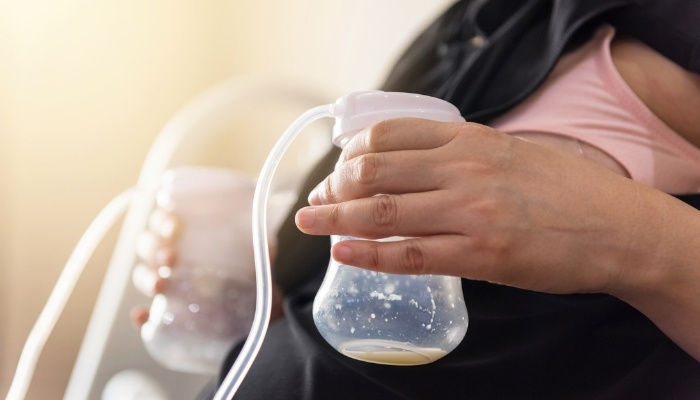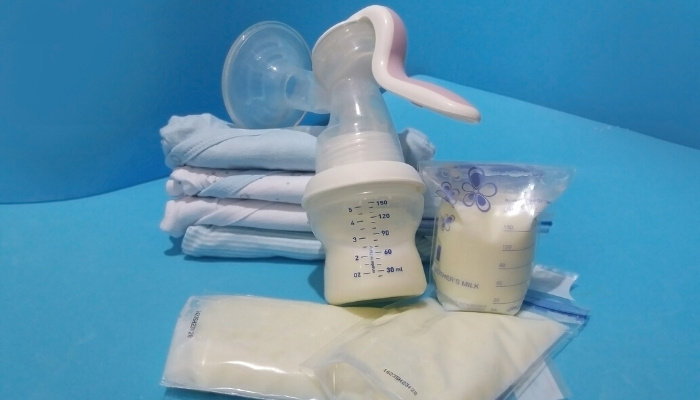- Method #1: Drop one pumping session, and schedule your other pumping sessions closer together.
- Method #2: Gradually decrease the duration and volume produced of one session until it is eliminated.
- Method #3: Slowly increase the intervals between sessions until one is no longer needed.
- Method #4: Drop one session cold turkey. Adjust the duration and timing of the remaining sessions.
It is recommended to gradually decrease the duration of your pump sessions in order to sustain your milk production. It is important to keep the total amount of time spent pumping each day consistent to prevent any decrease in milk supply.
BabyCenter warns:
“Breast milk supply is maintained by frequent nursing … If your pumping frequency doesn’t match your little one’s demand, you might see your supply dropping.”
Table of Contents
How To Drop a Pumping Session Without Losing Supply
Drop pumping sessions gradually to maintain your supply and avoid clogged ducts and other unpleasant symptoms.
Try one of these methods for dropping pumping sessions:
Method #1: Drop One & Schedule Remaining Sessions Closer Together
Try dropping one pumping session and scheduling your other pumping sessions closer together.
Pick a session in the afternoon, and combine it with another session over the course of a few days.
For example, if you pump every three hours, you might combine your 3 p.m. and 6 p.m. pumping sessions by pumping at 4:30 p.m. instead.
Then, you can adjust the rest of your pumping sessions and pump every four hours instead.
This is the method I’ve used in the past, and I had minimal discomfort and no change in overall production.
Method #2: Gradually Decrease Time & Volume of a Session
Another method for dropping pumping sessions without losing supply is gradually decreasing the time and volume of one session.
Shorten the pumping session length by about a quarter every five days. Cut your 20-minute session down to 15 minutes and so on.
Eventually, you’ll eliminate the session completely.
Besides decreasing time, you can also reduce the volume you pump during a session if you track the ounces you produce each time.
Instead of shortening the session time by 25%, gradually decrease the amount of milk you make by 25% every four or five days.
Method #3: Gradually Increase the Amount of Time Between Sessions
Begin by evaluating your current pumping schedule. Note the intervals between sessions and the total number of sessions per day.
Choose one pumping session, and delay it by 20-30 minutes. Keep the other sessions at their regular intervals initially.
Pay attention to how your body responds. Monitor your comfort level, and ensure that your milk supply remains consistent.
If you experience discomfort or notice a drop in milk supply, you may need to adjust the pace at which you’re extending the intervals.
Once your body adjusts to the extended interval for the chosen session, you can then extend another session in a similar manner.
Proceed gradually, allowing your body time to adapt without causing discomfort or a sudden decrease in milk production.
Once you’ve successfully extended the time between several sessions, you’ll find that one session is no longer needed.
For example, by extending a pump-every-3-hours schedule to pumping every 3 ½ hours, rather than 8 sessions, you’ll be down to just 7.
Method #4: Drop One Cold Turkey
This is the most uncomfortable option and could result in clogged ducts, mastitis, or other complications.
However, it is the fastest method and could be ideal for some women.
If you choose to try dropping a session cold turkey, simply drop the session in which you typically produce the least amount of milk or the one that is most inconvenient for you.
Consider rearranging your other sessions to even out the gap.
How To Decide Which Session To Drop
You should drop any session where you’re not producing as much milk, usually in the early afternoon.
Save dropping your first pumping session in the morning and the last pumping session in the evening for last.
During those pumping sessions, you tend to produce the most milk, so you should pump for those times for as long as possible.

Dropping a Pump Session – What To Know
If you’re considering dropping a pump session, here are some things you need to know.
What It Means To Drop a Pump Session
Dropping a pump session means adjusting your pumping routine so that you pump fewer times in a 24-hour period.
As you change your schedule to exclude one pumping session, your other pumping sessions should be more evenly spaced.
You’ll want to drop a pump session gradually over the course of a few days rather than dropping one abruptly.
When You Might Consider Dropping a Pumping Session
You might consider dropping a pumping session when your body is producing enough milk for you to breastfeed your baby to a point where they’re satisfied.
Think about the following as you try to decide whether you should drop a pumping session:
- How much milk are you producing when you pump? If you’re making more milk than your baby eats throughout the day, you may want to drop a feeding once your breast milk supply has been regulated.
- How old is your baby? You can think about dropping a pumping session if your baby is older than 12 weeks. Your milk supply has adjusted at this point to meet your baby’s needs, so you can drop a pumping session if your baby is satisfied after breastfeeding.
- How much do you want to pump? If your baby is gaining weight and you’re frustrated with pumping, you can start dropping some sessions gradually. If your baby isn’t gaining weight and you’re frustrated, speak with your baby’s pediatricians about other options.
- Are you going back to work? Pumping may become more challenging when you go back to work. Consider dropping a pumping session before you return to your job.
- How many sessions are you pumping each day? You may want to drop a pumping session if your breast milk supply has regulated and you’re pumping seven to eight times a day.
- Are you willing to supplement with formula if necessary? If your supply starts to decline, are you okay with giving your baby formula to make up for the loss?
- Has your baby recently started solids? Once babies start eating solids, dropping a pump session is often necessary as they’ll be substituting at least one regular feed with solid food.
Effects of Dropping a Pumping Session
The effects of dropping a pumping session are different for every woman.
Some women experience a drop in milk supply while others experience an increase.
If you drop a pumping session too quickly, you may develop uncomfortable breasts, clogged ducts, and mastitis.
You may also have mood swings because of the hormonal changes that come with weaning.
When To Start Dropping Pumping Sessions
If you’re pumping to increase your milk supply for breastfeeding, you can start dropping pumping sessions after about 12 weeks.
By that point, your milk supply should be established, and your baby should be satisfied with the amount of milk you produce.
If your child’s pediatrician is concerned about your child’s weight gain, you may want to continue pumping under the guidance of a lactation consultant.
When Can I Stop Pumping Every 3 Hours?
If you’re exclusively pumping, you can stop pumping every three hours when your baby is between 6 and 12 weeks old.
Once you’ve established your milk supply and your baby is satisfied with the milk you’re producing, you can start dropping pumping sessions.
Dealing With Discomfort When Dropping a Pumping Session
Dealing with discomfort while in the process of dropping a pumping session is crucial to ensure a smooth transition.
Remember that it’s important to listen to your body and adjust your plan as needed.
- Gradual Adjustment: Avoid suddenly stopping a pumping session as this can lead to engorgement. Instead, slowly decrease the frequency or duration of the sessions over several days or weeks.
- Hand Expression: If you’re feeling engorged or uncomfortable, use hand expression to relieve some pressure. Gently express a small amount of milk to alleviate discomfort without fully emptying the breast.
- Cold Compress or Ice Packs: Applying a cold compress or ice packs to the breasts for short intervals can help reduce swelling and provide relief. Make sure to wrap the ice pack in a thin cloth to prevent direct contact with the skin.
- Warm Compress or Warm Shower: Applying a warm compress or taking a warm shower can help stimulate milk flow and make it more comfortable to express milk. This can be particularly helpful if you’re experiencing any clogged ducts.
- Gentle Massage: Massage your breasts gently to help release any built-up milk and improve milk flow. Focus on massaging in the direction of the nipple. This can be done before, during, or after pumping or breastfeeding.
- Comfortable Nursing Bras: Wear a comfortable and supportive nursing bra that provides adequate support without causing compression. Avoid tight bras that may contribute to discomfort or impede milk flow.
- Stay Hydrated: Make sure you’re drinking enough fluids throughout the day as dehydration can exacerbate discomfort and may impact milk production.
- Over-the-Counter Pain Relief: If needed, you can take over-the-counter pain relief such as ibuprofen or acetaminophen. However, it’s advisable to consult with a healthcare professional before taking any medication, especially while breastfeeding.
If you experience persistent discomfort or you notice any signs of mastitis (such as redness, swelling, or fever), seek guidance from your healthcare professional promptly.
Signs Your Milk Supply Is Decreasing
Watch out for these signs that your milk supply is decreasing:
- Your baby isn’t producing enough wet diapers in a day.
- Your baby isn’t gaining enough weight.
- Your baby doesn’t produce tears when crying.
- Your baby has a sunken spot on the top of their head.
- Your baby is abnormally sleepy or lethargic.
How To Maintain Milk Supply
Follow these tips for dropping a pump session or two while continuing to make enough milk for breastfeeding your baby:
- Feed your baby on a schedule: Starting from a few hours after birth, breastfeed your baby every 2-3 hours in the beginning to establish supply. When your baby is gaining enough weight and you’re producing enough milk, you can start feeding your baby on a more on-demand basis.
- Be patient during growth spurts and sicknesses: Babies consume more milk when they’re growing or feeling ill. It may seem like you’re not producing enough milk, but eventually, your body will catch up to your baby’s needs.
- Consume a balanced diet: Eat a colorful diet of fruits, vegetables, proteins, and grains. Breastfeeding mothers should aim to eat 500 additional calories.
- Stay hydrated: Breastfeeding mothers need to consume more water than other individuals. Make sure you drink enough water so that you’re not thirsty throughout the day.
- Manage your stress: Your stress levels and hormones can affect milk production. Stay active and practice relaxation techniques to relieve stress throughout the day.
Mom of three (including identical twin boys), wife, and owner of Parents Wonder. This is my place to share my journey as a mother and the helpful insights I learn along the way.

